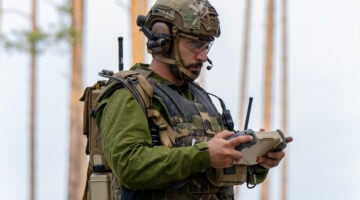
WASHINGTON — Air Force Research Laboratory is seeking bidders for a new initiative to develop new radars for a variety of intelligence, surveillance and reconnaissance (ISR) missions, including tracking moving targets for use by the Air Force, Space Force, Army and Navy.
Under the Science and Technology Applied RF Systems (STARS) program, estimated to cost a total of nearly $95 million over six years, AFRL is looking to award up to three indefinite delivery, indefinite quantity (IDIQ) contracts — with funding based on individual task orders, according to the lab’s solicitation. Interested vendors have until June 12 to respond.

“The objective of the STARS program is to develop advanced RF [radio frequency] capabilities which will provide sensing for all-weather day-night ISR using non-traditional radar modes for persistent surveillance across permissive, contested, and highly contested boundaries in multiple environments (e.g., air, land, sea, space and cyber space) to improve the capabilities of the Air Force and Tri-Service Communities,” the AFRL solicitation explains.
“These capabilities will provide sensing solutions for Passive Source Localization (PSL), Synthetic Aperture Radar (SAR), Moving Target Indication (MTI), as well as a myriad of enabling and complementary technologies and research areas including but not limited to Tracking, Automatic Target Recognition (ATR), Interference Suppression, and Modeling Simulation and Analysis (MS&A),” it adds.
The project seems to be seeking next-generation capabilities previously provided by the Air Force’s E-8C Joint Surveillance Target Attack Radar System (JSTARS), an aging aircraft the service reasoned is not survivable against updated Chinese and Russian anti-access/area denial arsenals. JSTARS carried an X-band radar for tracking targets on the ground.
That said, the AFRL solicitation uses broad language that suggests that the lab also is interested in exploring sensors for tracking airborne targets — a mission performed up to now by another aging aircraft, the E-3 Airborne Warning and Control System (AWACS). The Air Force has yet to finalize negotiations with Boeing on the successor to AWACS, the E-7 Wedgetail.
In response to Breaking Defense’s query about potential applications and uses, an AFRL spokesperson left the answer open — but did point out that the similar name of the project to JSTARS is “purely coincidental.”
“STARS is a broad solicitation covering a very wide variety of RF sensing technologies to potentially advance a variety of capabilities. It is anticipated that the R&D completed will ultimately support a variety of emerging and future Air Force needs,” the spokesperson said in an email.
Under the effort, contractors will be asked “to perform modeling, analysis, simulation, development, design, development, fabrication, testing, evaluation, demonstration, and conceptualization of radio frequency (RF) and multi-INT subsystems, components, devices, and electronics manufacturing technologies as well as leveraging past and ongoing advancements” from AFRL’s Sensor’s Directorate, the solicitation elaborated.
The program will assign task orders to winning vendors under four categories: algorithm and software design, development, and implementation; MS&A; lab and flight testing, and hardware development; and systems integration and transition planning, it adds.
The first task order will be focused on building a “digital development environment” to test emerging “RF sensor and RF sensor signal processing technologies” being developed both by commercial firms and the US government, the solicitation said. It will cover 12 months of activity.

